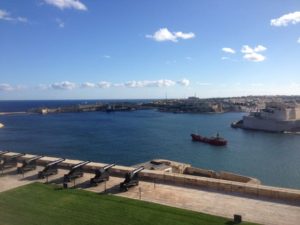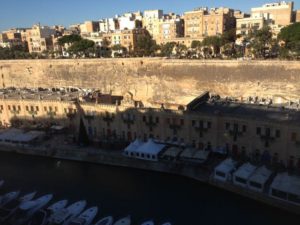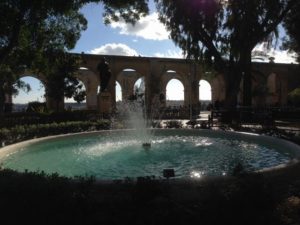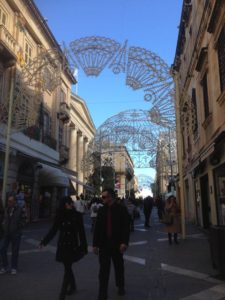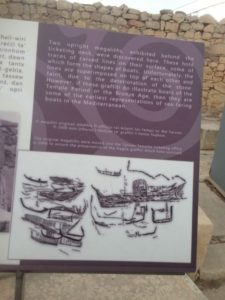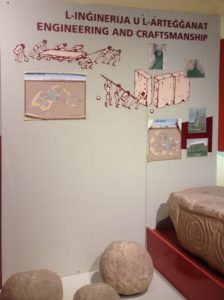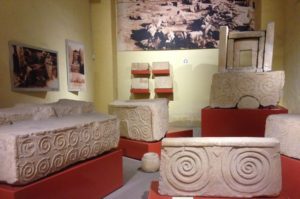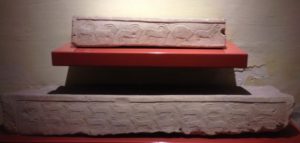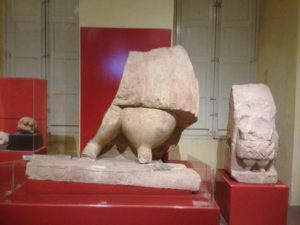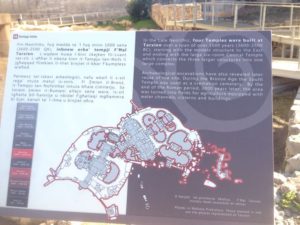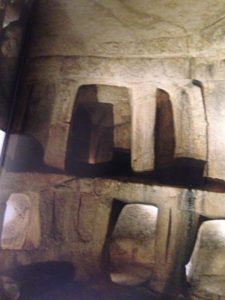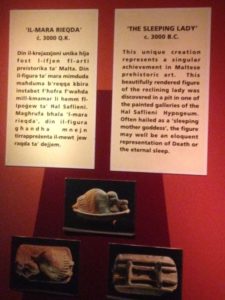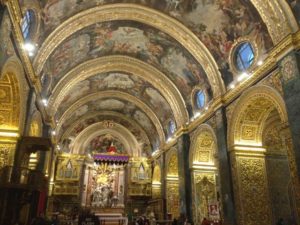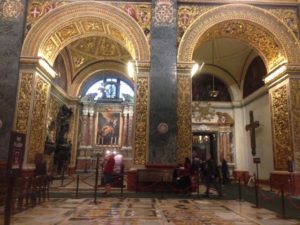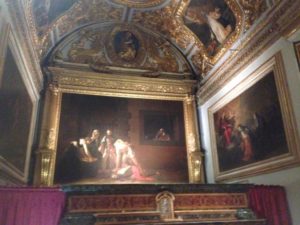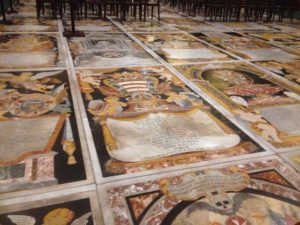We fell in love with Valletta, Malta. On both sides of the port, the city is fortified with beautiful golden sandstone walls, one reason they were able to hold off Suleiman the Magnificent in the siege of 1565.
We got a map from the tourist info right outside the port and were directed to the lift 500 m to the right. The lift rises
six or seven stories to the to the Upper Barrakka Gardens with a beautiful view over the harbor.
The city is very walkable, mostly pedestrian, and was decorated with lacy Chirstmas lights that we wished we could have seen at night.
On our way to St John Co-Cathedral, we passed a shop where we picked up sandwiches for a picnic at the Traxien ruins. The Cathedral unfortunately closed until 11:30 for a private event. We strolled the city some more and then headed to the bus stop where we caught bus 82 to Traxien ( 81, 83, 84, 85 will also get you there) in the town of Paola across the harbor from Valletta. The 25 minute ride took us through more beautiful sandstone monumental buildings and dropped us in a little park in Traxien. Without asking, we never would have found the temple site, down a side street from the park.
Malta has over 300 neolithic temple sites (built between 4000 BC and 3,000 BC. known as the Temple Period), an astounding number for so small an area with a population that they think never rose above 10,000.
The first settlers came to Malta around 7000 BC. Grafitti on one of the Tarxien stones (dates to 4,000 BC) clearly represents boats and is though to be the earliest representation of boats in European prehistory. The boats bear similarities to Egyptian boats depicted around 3000 BC.
The temples complexes were constructed using large blocks of limestone and are similar in shape, with one or more four rounded rooms around a central apse and surrounded by a defensive wall. By comparison the pyramids of Giza were built around 2500 BC.
It is a mystery how so many immense stones, some weight over 20 tons could have been moved into place. One theory is that they used round stones like ball bearings to move giant slabs of stone.
Hal-Tarxien is the closest neolithic site to Valetta (in the town of Paola across the harbor from Valletta ). Built from 45000 BC to around 3600 BC, it is a complex that contains the ruins of four temples, today sheltered under a giant cover to protect the ruins from the weather. Most of the carved stones have been removed to the Museum of Archeology in Valetta, where we saw them later.
Traxien was one of the most elaborately decorated 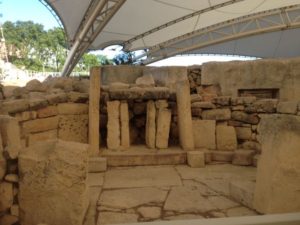 sites.
sites.
The most common motif is the spiral, but panels depicting processions of animals are also common.
One of the chambers contained the lower half of a colossal statue of a corpulent woman wearing a pleated skirt. The original stood two meters high.
Next, we made our way to the Hypogeum of Hal Seflieni, an underground necropolis, the entrance to which is hidden away down a side street. We never would have found it if we hadn’t asked directions numerous times. You have to have a reservation to get in (somewhere around 20 E each, and they recommend getting there 15 min early to keep your spot because they only let ten people in at a time (with a guide and audioguides). They carefully monitor the air quality of the site to protect it from decay because when it was originally opened, too many visitors increased the CO2 and algae began to grow on the walls, prompting them to close the site, restore it and carefully monitor the air quality. If you can possibly see Hal Seflieni when you are in Malta, you should do so.
It is one of the most amazing sites I have ever seen. Cameras are not allowed inside but I bought a book that had photos of the interior.
Seeing Hal Selflieni after seeing Traxien was particularly moving because we could see how the architecture of the necropolis mirrored the architecture of the temples. Hal Selfieni nd sanctuary/necropolis constructed on three levels (Upper, Middle, and Lower levels).
It was discovered in 1902 when someone was digging a cistern to store water and broke into one of the chambers. The chambers were carved out using stone tools and antlers to bore holes in the stone, which would then be chipped away. The upper Level is the oldest (4000BC) was formed from a series of natural cavities which were modified and enlarged. The Middle Level, entirely hewn, appears to be a transition between the surface and the chambers below. The rock has been carved into decorated pillars, doorways, and corbelled ceilings, imitating the megalithic buildings above ground. The burial chambers are niches, windows, and changes in level. Many have spiral motifs painted in red ochre.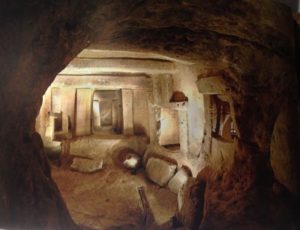
The Sleeping Lady (3000BC), found at Hal Saflieni, depicts a large woman reclining on a bed with her eyes shut and her head resting on her right hand. She wears a long pleated skirt but her breasts are bare. Similar to other figures found here, she may well be a representation of eternal sleep.
With more directions we found the bus stop back to Valetta (any double digit bus will take you back).
Like Palermo, Malta was ruled over by the Phoenicians, the Romans, the Arabs in the ninth century, the Normans in the eleventh. In the middle of the 1500’s it was given to the Knights of St. John, the Knights of Malta. The Maltese falcon was their yearly tribute to the Emperor in return for their control of the island. It remained theirs until Napoleon took it on his way to Egypt in 1798 until Lord Nelson took it back and made it a British colony, which it remained until 1964. Malta still has a strong British presence.
On our return to Valletta, we had time to visit Saint John’s Co-Cathedral, the church of the Order of Knights of St John, whose members contributed vast sums for its ornamentation.
The Knights were noblemen from the most important families in Europe, and their mission was to protect Europe from the attacks of the Ottoman Turks. After successfully defending Malta (ad the rest of Europe) from Suleiman the Magnificent in 1565, they turned Malta into a bastion to protect Europe.
The Baroque cathedral was completely in 1577 and contains the paintings of the best painters of the time, including two large Caravaggios, The Beheading of John the Baptist, and St Jerome, both of which were painted while Caravaggio was in Malta, having escaped a murder charge in Italy. He was later expelled from Malta for another violent attack.
The floors are richly inlaid marble.
Malta is charming and worth a longer stay to explore its beaches and ruins.




